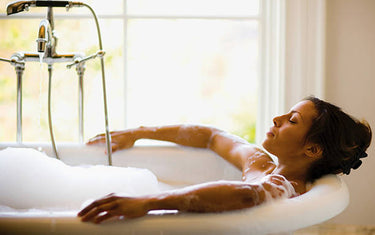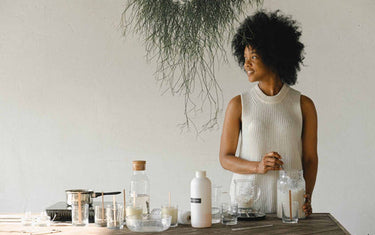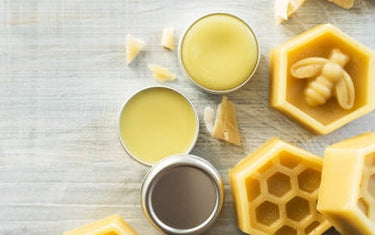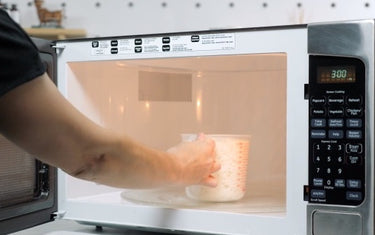5 min read / 21 December 2023 / yasmin sharp
How to Make Perfume With Essential Oils
From fragrance selection to application tips, learn the art of making a personalised perfume that's uniquely yours.
Share this post
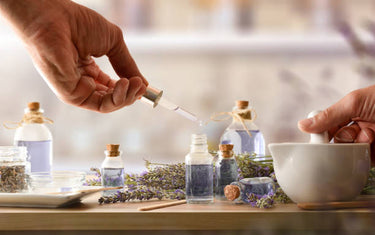
Learning how to make your own perfume can be a lot of fun, allowing you to create a signature fragrance that is personal to you.
If you struggle to find fragrances that reflect your personality or character and you don’t just want an ordinary, everyday scent that makes you smell like everyone else, then you could try using essential oils as perfume.
Essential oils have a long and rich history of being combined to make fragrances and scents, so we’ve put together some tips on what you need to do to make your own at home.
How to make perfume with essential oils
Once you’ve chosen your fragrances, completed the relevant patch tests, collected your materials and settled on a dilution ratio, you can follow these steps for our DIY perfume recipe:
- Using a pipette, add 80 drops of carrier oil to the rollerball bottle.
- Add 6 drops of a top note, 10 drops of a middle note and 4 drops of a base note, making sure to use a separate pipette for each oil.
- Replace the lid on the bottle and shake well (also do this every time you use it).
- Put a label on the bottle so you always know what fragrance is inside.
- Keep the bottle stored in a cool, dark space away from direct heat and light sources.
How do I pick a fragrance for my perfume?When it comes to learning how to make your own perfume, there are several different fragrance categories that can help you narrow down your options for your perfume:
|

What is the best carrier oil to use for natural perfume?
When using essential oils as perfume, some of the best carrier oils to use include:
- Jojoba oil: Closely resembles skin's natural oils, absorbs easily, and helps retain fragrance longer.
- Fractionated coconut oil: Remains liquid at room temperature, has a neutral scent, and absorbs quickly into skin.
- Sweet almond oil: Rich in vitamins A and E, nourishes skin while providing a smooth base.
- Grapeseed oil: Lightweight, non-greasy, and rich in antioxidants. Enhances fragrance without overpowering it.
When choosing a carrier oil for perfume, consider:
- Skin type: Lighter oils like grapeseed work well for oily skin, while richer oils like jojoba suit dry skin.
- Scent compatibility: Neutral-scented oils work best with strong fragrances.
- Absorption rate: Faster-absorbing oils are ideal for all-day wear.
Do I need to complete a patch test for my perfume?
Whilst some essential oils are stronger than others, they all pose the risk of causing skin irritation or an allergic reaction, even when diluted correctly.
If you are a first-time user of an essential oil, you should complete a patch test to check that it is compatible with your skin:
- Dilute a small amount and apply to the inside of your elbow.
- Cover with a plaster and leave for 24 hours.
- If you do not notice any signs of irritation, redness, itchiness etc. the oil should be fine to use.
What materials do I need for making perfume with essential oils?
Before you move on to learning how to make perfume with essential oils, you’ll need to gather together the right materials and equipment:
- 1 x 5ml rollerball bottle (for storing the perfume)
- 1 x unscented carrier oil, such as almond oil or jojoba oil
- 3 x essential oils (high, mid and base notes)
- 4 x pipettes for the carrier oil and essential oils
You will need a minimum of three essential oils for your perfume, but as you become more experienced you can start to experiment and increase the combinations.

What oil dilution ratio should I follow for my perfume?
Essential oils are highly concentrated because they retain many, if not all, of their natural plant and herbal properties.
So, to keep your skin safe, it is recommended that you use a 20% concentration of essential oils in your carrier oil mixture.
A 5 ml rollerball bottle will require around 100 drops of liquid extracted from a pipette – as 1 ml roughly equates to about 20 drops.
This means you will need 80 drops of carrier oil mixed with 20 drops of essential oil.
For beginners, a good rule of thumb to follow is the 30/50/20 rule. This means you add 30% of a top note (6 drops), 50% of a middle note (10 drops) and 20% of a base note (4 drops).
If you have completed a patch test but have sensitive skin and are concerned about a potential reaction, you can lower the essential oil concentration to around 15%.
What is the best way to apply an essential oil perfume?
The final part of learning how to make your own perfume is understanding how to use it. The way you apply your perfume may differ depending on the type of bottle you use, giving you the option to spray, dab or roll it onto your skin.
Like any perfume, the best areas to focus on are pulse points, as they emanate more heat, which increases the scent throw of the fragrance.
Behind your ears, the back of your knees, on the inside of your elbows and on your wrists and throat areas are key pulse points that can increase the strength of your DIY perfume.
Other areas you apply the perfume for a lasting impact include the nape of your neck and collarbone, across your chest and the top of your arms.
Obviously, you don’t want to apply the perfume to all these spots at once, as it will probably be too overpowering, but applying it to about 3 or 4 areas should give the fragrance staying power.

You can use essential oils as perfume in lots of different ways, with a countless number of scent combinations you can try to create the perfect scent, just for you.
Or, once you’ve gained some confidence in your blending skills, you could also make a personalised perfume as a gift for a loved one, friend or family member.
Whatever you decide to do, if you are using an essential oil for the first time, make sure to complete a patch test to reduce the risk of irritation or allergy issues.
Just as importantly, have fun with the process, as once you master the technique, you can quickly build up a dresser full of fresh and exciting fragrances that are completely unique to you.
Looking for savings on your essential oil and carrier oil purchases? Sign up for our wholesale account today to unlock discounts exclusive to our wholesale customers.


